#like that ''duck season!'' / ''wabbit season!'' looney tunes episode
Text
Pixiv allows people to add tags to other users' posts, which is a helpful idea in theory, but in practice, it ends up feeling like PVP mode half of the time. Artists vs. the random people who keep adding filler tags or things like "what the fuck" to their posts. Imagine if tumblr or Ao3 let us do this. It'd be like back when we could edit text in reblogs to make it look like OP said something heinous except worse because the tags would stay on OP's post until they noticed and deleted them
#my favorite is seeing a tag come and go on a post bc people keep adding it and the artist keeps removing it#like that ''duck season!'' / ''wabbit season!'' looney tunes episode#thankfully you can disable tag editing for your posts if you want#shoutout to the person who added the ''what the fuck/crack'' tag to one of my posts because they didn't like the way i drew the character#i removed the tag (and turned edits off) but omg imagine being that rude#i need a new personal tag
10 notes
·
View notes
Text
HAPPY LATE 83rd BIRTHDAY TO ELMER FUDD!!! (2 MARCH 1940)
Elmer Fudd shares his birthday with Porky Pig (something which I admit I didn't know until reciently). Until now, I have encountered many posts that wish happy birthday to Porky, as well as even showing a brief history of the character (which I'm glad to see!), but none for the poor nimrod. Therefore I decided I'll do it, albiet lately. Here's a short history of Elmer Fudd and how he evolved to be the character that we all know and love:
Although Elmer's official appearance is considered to be in Elmer's Candid Camera (2 March 1940), his origins date much further that that.
Many people think that it all started with Egghead, a dim-witted human-like cartoon character, with a bulbous nose and an egg-shaped head, who later evolved into Elmer Fudd but that aspect is somehow debated by cartoon historians.
The true very early version of Elmer Fudd appeared in Little Red Walking Hood (1937). Here, he had a derby hat, small squinty eyes, big reddish noise, a high collar around his neck, a green long sleeve shirt, green pants, and a bald circle-like human head.
After that, he appeared in more shorts throughout the late 30s. In the 1939 cartoon, Dangerous Dan Mac Foo, a new actor, Arthur Q. Brian, voiced Elmer and gave him his well-known speech impediment.
His official first appearance was in Elmer's Candid Camera (2 March 1940), alongside an early version of Bugs Bunny.
In his early cartoons Elmer alternates between being a hunter, like in A Wild Hare (1940), or a mild-mannered fellow who "wikes wabbits" and wants to adopt or take pictures of them, before Bugs drives him insane (Elmyra Duff, his counterpart in Tiny Toon Adventures, might be inspired by this version of him).
For a short period of time, between 1941-42, Elmer Fudd was given a new design, making him a heavy-set, beer-bellied character, patterned after Arthur Q. Bryan's real-life appearance, and still chasing Bugs (or vice versa). The audiences didn't like him however, so the slimmer version of the toon returned for good.
In the 50s, three gems of cartoons came out today known as the Hunting Trilogy: Rabbit Fire (1951), Rabbit Seasoning (1952), Duck! Rabbit, Duck! (1953). These cartoons solidified Elmer's reputation as a hunter and his dynamic with Bugs and Daffy
Elmer's official role became the one of a hunter and foil for Bugs Bunny. Even today Elmer Fudd is considered to be Bugs' classic nemesis, despite the fact that the wabbit has had many more enemys throught history (such as Yosemite Sam, Daffy Duck, Wile E. Coyote, Marvin the Martian or Taz). Traits of his character solidified such as his gulibillity, short attention span, short temper and mild manners. The duo is such a classic that in the late 1950s cartoon, Bugs' Bonnets, in which the two of them try on different hats. This leads to a mayhem that ends with matrimony.
The only time Elmer won against Bugs was in Hare Bush (1956), where they swich roles
Elmer also played other roles such as Cupid in The Stupid Cupid (1944), which also starred Daffy Duck
He appeared in the 1990s series, Tiny Toon Adventures as Elmyra's mentor and a teacher at Acme Looniversity
He didn't play a huge role in either Baby Looney Tunes (2002) or The Looney Tunes Show (2011), but he did appear in a lot of episodes in Looney Tunes Cartoons (2020) as one of Bugs' main antagonists. This time however, he doesn't have his usual shotgun, due to the increase in gun violence in America.
So... as I was saying, HAPPY 83rd BIRTHDAY ELMER FUDD!!!!<33
#looney tunes#elmer fudd#happy birthday elmer fudd#bugs bunny#daffy duck#tiny toon adventures#elmyra duff
10 notes
·
View notes
Note
fav design characteristics of each daffy, go!
UM. UM. i started gathering images but realized i’d hit the limit way too soon so just take what i have now and look at them. very good aren’t they?
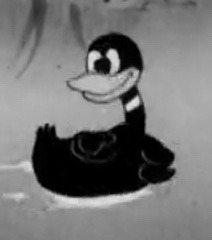
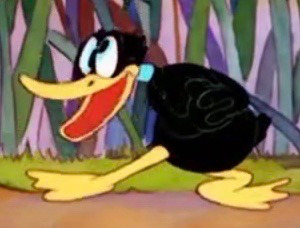

UMMMM i’m just going to go all in by director and incarnations because you give me too much power to talk
tex avery’s daffy: first two you see above. small and silly. i LOVE the blue neck ring especially and the blue irises. he’s so small and ready to cause trouble
bob clampett’s daffy: probably the most influential to my own. there’s a lot of variations in his daffy(s) but i LOVE how it blends the duck look and more “””humanoid””” look so well, leaning more towards duck. his head is really tall and lean and i think it’s funny. his early daffy (third image) is adorable
friz freleng’s daffy: i like how it always looks like he’s chewing on something. his daffy is my favorite model of his ‘50s models too
norm mccabe: unsung daffy hero i actually forgot about him. his daffys are the cutest hands down i love how ducklike and round they are and the way his eyes look. oh these are all so good. maybe not weird enough or ugly for my liking i still like a bit of that offbeatness to him (which is why clampett is my fave) but these are adorable. also he talks to the audience a lot which is nice :) i lied here are more pictures
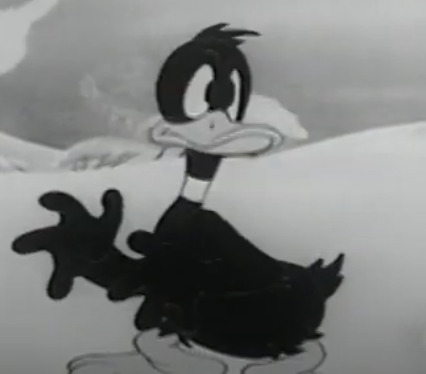
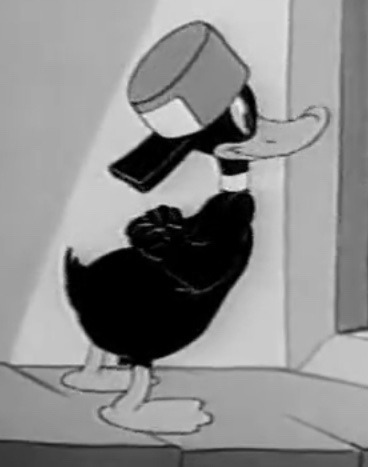
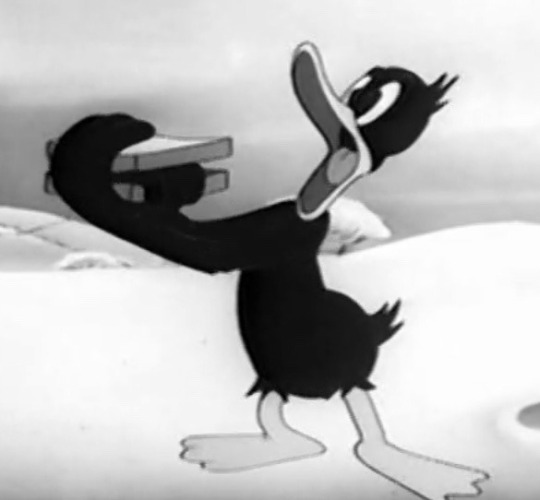

chuck jones’ daffy: i don’t like his redesign at all i’m sorry 😔 i don’t like the wide bill or the humanoid look BUT. his daffy is often cuter than i remember so there is that. his 40s daffys however are so so so cute. so small i love it
frank tashlin’s daffy: SO DYNAMIC he’s really skinny and lean and perfect for being pushed into dynamic poses. another fave
bob mckimson: his daffy is probably the funniest just because he makes funny faces all the time. he’s so small and ducklike even well into the ‘50s and i respect that immensely
art davis: ANOTHER REALLY CUTE DAFFY his daffy has like. fork hair. and it’s really really good
those are the primary directors so i’ll move on to other incarnations uhhhhh let’s see
space jam: looks like bob clampett’s daffy so i love it
back in action: not really a fan but he can also be cute. i don’t know what my favorite aspect is... the more ducklike the better
duck dodgers: can actually be really cute at times despite my Duck Supremacy. sometimes they give him a chipped tooth which i think is interesting
the looney tunes show: very very very cute in the first couple of season 1 episodes. i wish they stuck with the laff riot look... he had big eyes especially during this period and it’s really good. i like his spiky tail
wabbit: wabbit doesn’t have my favorite set of designs but i’m forever grateful that they made him look like his ‘40s self again. the storyboards especially look 1000x better than the show itself
looney tunes cartoons: UGH SO GOOD again ‘40s daffy reigns supreme. i really like how they draw his fingers. that sounds odd but i like them they’re. delicate? pointy? i sound like a certified freak right now but. it happens
this isn’t very succinct because it’s just me going “he’s cute except for here :)” and not really providing evidence LOL BUT. the more ducklike the better. funny and weird is always a plus too
25 notes
·
View notes
Text
Looney Tunes on HBO Max Review
Looney Tunes Cartoons (2020)
“Looney Tunes Cartoons” is a new series of Looney Tunes shorts made specifically for HBO Max. Intended to carry on the legacy of the Golden Age, the shorts have returned to seven minutes in length, a live orchestra has been hired to produce each soundtrack, and characters have been reverted to chaotic personalities.
The only season listed here shows ten episodes available to view. Each episode links to an eleven minute video containing two shorts. So 20 shorts in all are available to view at once (contrary to the rumor a handful would be released in weekly installments). This is not counting inbetween animations, which are roughly fifteen second gags bridging the shorts.
The art direction is the first notable thing about these cartoons in my eyes, it is a clear callback to the 1940s golden age. Going further in, one will find that every facet of this cartoon is a Animation is very good and the orchestration is fantastic, once again from a live orchestra. The writing on this show is storyboard driven, as it was in the original shorts, and allows room for visual gags and physical comedy. The writing evokes the characters original counterparts most convincingly out of anything I’ve seen this past decade. This is a difficult practice, and you can see every facet being done with admiration and enthusiasm.
I’m sure the voice acting helps with that as well, many voices are spot-on, and Eric Bauza’s Bugs Bunny is the closest to Mel Blanc’s I believe I’ve ever heard. Auditory gags, such as giving the cute animal characters a deep shouting voice, return to my great entertainment. Even what appear to be one-off human characters have distinct voices that seem straight out of a golden era cartoon. The amount of consideration, care, and quality in this show is extrodinary.

How Many Theatrical Shorts are Present?
There are 209 original Looney Tunes shorts are present (one not being theatrical the made-for-TV short Duck Dodgers in Attack of the Drones (2004)) The shorts are broken up over 31 seasons that vary in length from three to twelve episodes per season. Each season features shorts from differing years, although they are listed chronologically.
Season 1 starts with Foxy’s Smile Darn Ya Smile! (1932) and then skips to Hollywood Capers (1935). Interestingly, Smile is listed as episode 1, while Hollywood is listed as episode 4, perhaps implying that two more shorts will be released between them eventually. Each “season” listed has films numbered erratically like this, indication that we may see many more shorts in the future. The longest season lists its last short as “Episode 21″ which may indicate how long seasons can get in the future.
Broken down there are 17 shorts from the 1930s, 78 from the 1940s, 81 from the 1950s, 29 from the 1960s, and 4 from 1987-2004.

Are More Modern Television Series Present?
Some of them! All two seasons of the Looney Tunes Show (2011) are present, which I’m most excited about. Additionally, all five seasons of Sylvester and Tweety Mysteries (1995)
There are again, some hangups for me. No other LT TV shows are present besides those. Duck Dodgers (2003) is a TV show I would have been excited to see. Hell, I would have watched Loonatics Unleashed (2005) if I was paying for it.
For fans of the spinoff characters, no Tiny Toon content, Baby Looney Tunes (except for a direct-to-VHS mentioned later), or Animaniacs media is available, the latter coming as a surprise to me due to its upcoming reboot.
It seems however, that they are still adding contnet! There is an HBO Max trailer for Wabbit (2015) available on the service, yet the full series is not currently available. This post may be updated when more content gets released.

Are Movies and Specials present?
Not really, no. Which is a huge disappointment for me. The two big modern theatrical films are not present: Space Jam (1996) and Looney Tunes: Back in Action (2003) are unavailable to watch. I’m especially surprised about Space Jam, considering the sequel in the works.
Direct-to-VHS Baby Looney Tunes: Musical Adventures (2003) is present, however, if you are inclined to watch that.
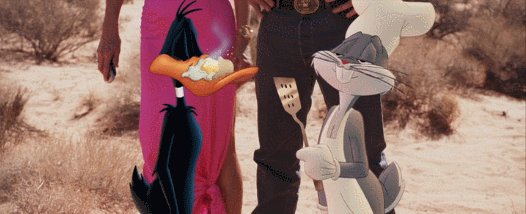
Is it Worth It?
To Support Looney Tunes Cartoons (2020) - 10/10 They deserve your support, please by all means.
To Watch Golden Age Cartoons - 7/10. I’m giving it a seven solely because this is the biggest collection of the classic shorts I have seen on streaming so far. This rating only reflects their current inventory of shorts.
Overall - 6/10. I’m still a little upset at the movies and TV series they are missing. I may have set my expectations too high, but for the high price point, I feel like there are some major gaps in HBO Max’s library. Again, this rating only reflects their current inventory of shorts.
HBO Max gives you a 7-day free trial before you have to start paying monthly. I may cancel during the free period of HBO Max after watching Looney Tunes Cartoons, and seeing some original shorts I haven’t yet. I would recommend doing this for anyone who wants to support the cartoons.
#long post#reviews#hbo max#hbo max review#looney tunes#looney tunes cartoons#looney tunes cartoons review#ltc#resources
49 notes
·
View notes
Text
Essay on my opinion about shock humor and gore in animation under the cut, please note that everything stated in this post is my own point of view and that I’m not setting myself up as an authority who thinks that his word is somehow what everyone should think (*cough* Nostalgia Critic *cough*) but this is a topic which I have thought about for a bit so I wanted to write about it and get my own views straightened out.
Basing your whole career on shock humor is a bad idea. It gets boring after the first time and generally you need to have more types of humor at your disposal to be able to have a well-rounded career in comedy. It’s the equivalent of jump scares in horror--they can be done well and used to great effect, but only if your film isn’t just “Jump Scare--the Movie!”
In animation aimed at adults, shock humor ABOUNDS, and there’s a stereotype that it has to do the joke of having a character get seriously injured and have it be really gory. This is something that is especially prevalent in things that have come out since the 2000s, with the idea being that in order to push the envelope of what’s acceptable on TV, we have to show more gore than ever before, and the whole underlying joke of this is:
“haha, cartoon man bleed!”
The basis of this joke is simple: since classic cartoon characters don’t usually get seriously injured (see Who Framed Roger Rabbit where the fact that the Dip can dissolve toons where nothing else could harm them is a major plot point), reversing the idea and having actually realistic harm come to them is somewhat funny because it’s unexpected.
The problem is that animation has expanded to the point where death and violence are a major part of them anyway depending on the film (look at something like The Lion King or Into the Spiderverse), and that people have done this same “joke” so many times that all of the shock value has disappeared and it’s boring.
But let’s look at classic cartoon violence for a moment and see why that works and why it’s funny, before looking at how some adult-oriented shows treat violence.
When most people think of cartoon violence they think of Looney Tunes, the series that perfected the convention. In the world of Looney Tunes, there are several rules about violence that are more-or-less consistent throughout:
1) Only the character who INSTIGATED the violence gets injured. In the Wabbit Season/Duck Season shorts, Daffy is specifically trying to get Elmer to shoot Bugs because it’s actually Duck Season (cue a ton of fake Rabbit Season signs placed all over by Daffy). Everyone has experienced something like this at some point in their life, someone going out of their way to hurt them in some way, so it’s cathartic to see Daffy try so hard to hurt Bugs only to fall into his own trap and get shot OVER AND OVER AGAIN WITHOUT LEARNING.
2) The injuries are almost never serious or life-threatening. Daffy gets shot a lot but all that results from that is his feathers are blasted off and his bill pushed into a different position on his head (and in one memorable instance, his entire head got blown upside-down somehow). This is because for the majority of human beings, seeing blood gushing everywhere isn’t funny, it’s disturbing, so while we want Daffy to get his deserved comeuppance, we also want to see it happen in a way that is more humiliating than harmful, to paraphrase Chuck Jones (who should know). Occasionally characters are killed in massive explosions but this is usually presented as an ironic twist at the end of a cartoon (the audience finally applauds Daffy after he blows himself up, but as his ghost rising towards Heaven laments, “I can only do it once!”) and they’re back to wreak havoc once more in the next one.
The problem with the “haha cartoon man bleed!” joke is that it destroys everything that makes classic cartoon violence funny in favor of shock humor. The characters who are hurt AREN’T bad people getting their comeuppance and their injuries AREN’T comparatively mild enough that even when they are the villain it’s not funny to watch. And then they just wipe away the consequences in the next scene anyway so there was no real point to maiming the character that gruesomely if you’re not going to own it and have them be dead for at least the rest of the episode.
While this specifically is what people are usually riffing off of when they have blood and gore in their cartoons, not all shows aimed at adults do this, and there are different ways to approach violence that go beyond “haha cartoon man bleed!” that more content creators should make note of.
1) In The Simpsons, some violence is cartoonish and consequence free (Homer strangling Bart for instance, or Sideshow Bob’s numerous run-ins with rakes, cacti, and other various items familiar to Wile E Coyote), while others are serious (Mr. Burns ended up in the hospital after being shot, Homer was in a coma after being blown up and also thought that he could die after eating incorrectly prepared sushi), but that tends to be based more around the tone of the event in question, so it’s flexible enough to give the writers some leeway. And in the Treehouse of Horror annual Halloween specials, the joke isn’t just that the characters are dying but that this goes against all of the rules of the world of The Simpsons and therefore the excesses that they go to are ludicrous.
2) In South Park, the tone is generally more like real life than The Simpsons, with fantastical elements stuck in for good measure (Trey Parker and Matt Stone having been inspired by urban legends surrounding the titular community that they heard while growing up). Seemingly belying this though is the running gag of Kenny’s deaths in every episode, something which Parker and Stone later abandoned because it got too tedious to try to come up with funny new ways to kill him. It was later retconned into his parents being cursed by Cthulhu so that every time he dies, not only is he reborn but everyone’s memories of him dying before are wiped clean. What Parker and Stone are good at with South Park is in using shock humor as social commentary--their whole movie is about their view of the quixotic nature of censorship and how parents will blame the creators of content not made for children when their kids see it rather than being good parents and being a part of their children’s lives, and this carries over into their treatment of violence. While their creative decisions aren’t ones that I agree with most of the time, I can still see that they are actually putting thought and care into their work, something that absolutely can’t be said for everyone in the adult animation industry.
Which leads us to
3) Family Guy and the rest of Seth MacFarlane’s oeuvre. Family Guy is what happens when you take the Treehouse of Horror segments and divorce them of the context that This Is Not Normal, and add in South Park’s shock humor as social commentary without the social commentary. The result is something where one of the primary jokes is “haha cartoon man bleed!” when the tone is more like a weird heightened reality and therefore it doesn’t “land” as that sort of joke except in the fact that it’s animated. Peter Griffin and the rest are so very clearly not “cartoons” in the way that Daffy Duck or Wile E Coyote are, so it’s basically like if you had a live-action film where people kept getting grievously injured but also erased the consequences of that for the next shot. This is the apogee of lazy writing on par with MacFarlane’s other stock joke, “haha animal and baby talk!!!”
4) In The Venture Bros., we’re basically treated to a live-action show that is animated, and violent death is a HUGE part of every single episode since the premise is “adventure series with kid sidekicks but done with real world rules”. The joke is that if people acted like characters from those old books and shows did in real life, they’re either incredibly stupid or violent psychopaths. It’s still shock humor, and it’s usually not particularly well done beyond “BLOOD!!!!!” but it still beats out Family Guy because the joke isn’t just “haha cartoon man bleed!” but rather a social commentary about our world. (The fact that their view of the world is EXTREMELY nihilistic is a topic for another day.)
5) Similarly, the “lore” of the game Team Fortress 2 has a ton of violence but differently than The Venture Bros., where morality is only found in the naive title characters and even then it’s more a product of them being too stupid to have a different worldview, most of the main characters of TF2 aren’t actually evil. They just happen to have the job of Blowing Things Up and Killing Enemies, and the comics even make it clear that in their world, there’s a difference between having that job and being an evil person. They’re also the only franchise on this list who actually do jokes featuring gore that go beyond the fact that it happened and are more akin to the “splatstick” style of Peter Jackson’s early films, which whether or not that’s something you can stomach gives them a point for more creativity.
All this is a very long way to say that people involved with the cartoon industry need to realize that expecting the joke of extreme violence to be funny in and of itself is both a bad strategy and is making it so any hacks can write a show without putting any thought into it and it gets approved because that’s what shows “do”. And creators need to realize that just because South Park or The Simpsons did something, you can’t just copy them while getting rid of the context that actually made the jokes land and expect to have something good.
7 notes
·
View notes
Text
Looney Tunes Episodes, if Cartoons Were as Political Today as They Were When Bugs Bunny Killed Hitler
(adsbygoogle = window.adsbygoogle || []).push({});
Elmer Fudd is elected president of the NRA.
Porky Pig becomes a speech & language pathologist and an anti-bullying activist. Daffy Duck and Tweety Bird both publicly endorse his work.
Foghorn Leghorn realizes he has a patriarchal tendency to dominate conversations. He reflects and decides he’d like to make a change. He goes on a Listening Tour to learn to be a better ally.
Penelope Pussycat hits a breaking point and files a workplace harassment complaint against Pepe Le Pew. Pepe is called into HR for a very awkward meeting. Enraged, Pepe becomes a Men’s Rights Activist. He does not get disciplined or fired.
Tired of being “othered,” Marvin the Martian becomes politically active. A technologist at heart, he is initially attracted to the libertarian party, but quickly realizes that none of their policies are effective in the real world. Instead, he joins the Democratic Socialists of America. He runs for congress on a far-leftist platform, and, in an upset, wins! Many of the ‘Toons doubt the sincerity of his change of heart, and treat his political ascent with suspicion.
Wile E. Coyote takes matters into his own hands and builds The Wall. To reward himself for his hard work, he engages in his favorite hobby: pursuing Road Runner. He buys some Acme™ TNT, attaches it to a trip wire in the road, and waits. Road Runner runs into it, but instead of detonating the TNT, Road Runner drags it along with him – all the way to the border wall! As Road Runner speeds past, the dynamite catches on the wall and explodes, bringing the whole thing down. Road Runner is unscathed; Wile E. gets second-degree burns.
Elmer Fudd lobbies congress to enact a law ensuring permanent open access to assault rifles, and ongoing open season on wascally wabbits. He’s horrified when, in the middle of his big presentation, his gun goes flaccid. He desperately peers down the barrel of his droopy gun in hopes of fixing it, but instead, the gun discharges into his face! Thankfully, Marvin the Martian’s anti-violence coalition has already successfully banned the sale of most types of ammunition, so the bullet in Fudd’s gun simply unfurls a small flag reading “Maybe there’s a better way.” Sooty and dejected, Fudd leaves congress in a state of total humiliation. Foghorn Leghorn happens to be in DC at the same time, doing some consulting work for an NGO to help them improve their engagement with the crucial Bird Cartoon demographic. He crosses paths with Fudd and spends a long time listening to his tale of degradation and failure. Sensing Fudd’s desperation, he gently suggests that Fudd connect with his good friend Pepe Le Pew, a former Men’s Right’s Activist who came to the realization that his anger and entitlement were almost as toxic for himself as they were for the women around him, spent many years in therapy unpacking why his identity was so closely tied to his sexual conquests, and finally realized that his constant search for sexual validation was a hedge against the profound feelings of inferiority that grew out of having cold, distant parents, and also stink glands. Foghorn tells Fudd that Pepe now does therapeutic work with other men whose fragile masculinity causes them pain and suffering, and gently wonders if Fudd’s preoccupation with firearms masks a deep-seated hurt that could be healed. Feeling truly seen for the first time in his life, Fudd breaks down sobbing. He knows the road ahead of him will be long, and that therapy will require his commitment and hard work, but even the idea of moving past his feelings of inadequacy brings him tremendous relief.
A Prius falls on Wile E. Coyote’s head and the impact folds his body up like an accordion, making him wheeze chords as he walks.

Looney Tunes Episodes, if Cartoons Were as Political Today as They Were When Bugs Bunny Killed Hitler was originally published on Weekly Humorist
0 notes